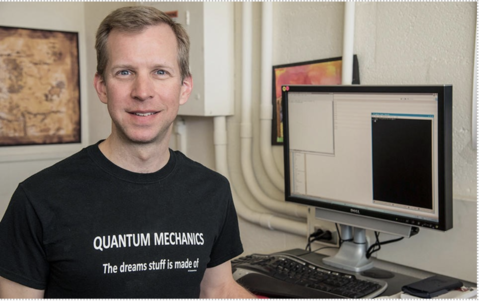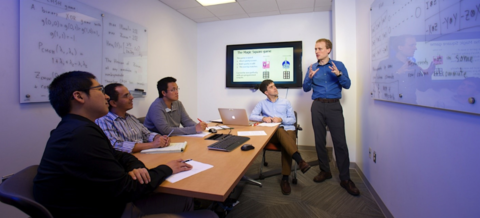Quantum Information Theory
Dates: 2001-2022
NIST mathematicians and statisticians have made fundamental contributions to the development of techniques to exploit the counter-intuitive properties of quantum mechanics for performing information technology tasks impossible for classical computers.
NIST’s now robust quantum information science program began shortly after Peter Shor’s 1994 paper in which he described an efficient quantum algorithm for factoring large numbers, something not thought possible for classical computers. If quantum computers can factor numbers quickly, then they will break the security of public-key cryptography systems which today are the basis for secure internet transactions. The realization that there were practical applications for the then obscure field of quantum computing started an avalanche of research worldwide which continues unabated. One of NIST’s earliest contributions was the 1995 demonstration by physicist Dave Wineland and colleagues of the first-ever deterministic multi-qubit logic gate using trapped ions.

Work by NIST mathematicians and statisticians on theoretical techniques and tools for assessing the fidelity of quantum states and processes created in the laboratory have played an important role in many other NIST quantum information “firsts,” including
- Deterministic teleportation of atomic qubits [1]
- Realization of quantum error correction [2]
- Implementation of the semiclassical quantum Fourier transform in a scalable system [3]
- Creation of a six-atom “Schrödinger cat” state [4]
- Demonstration of a single-qubit gate error below 10-4 in a trapped ion [5]
- High-fidelity universal gate set for 9Be+ ion qubits [6]
- Quantum gate teleportation between separated qubits in a trapped-ion processor [7]
Performing quantum logic operations with very high levels of fidelity is very challenging. It is known theoretically, that if errors in such gate operations can be kept below a certain threshold rate, then quantum error correction can be employed to enable computations to be successful. Such thresholds were thought to be very small, e.g., 10-4, far from what was attainable in the early 2000s. In 2005 however, a NIST mathematician showed how quantum computations could be done with devices with an error rate as high as 3 %, provided that one is willing to pay a larger price in error correction overhead [8].
Since the fidelity of gate operations is an important indicator of the readiness of qubit technologies for quantum computation, reliable methods for their assessment are needed. NIST mathematicians devised and demonstrated a method known as randomized benchmarking, which allowed such assessments to be reliably made while also verifying the stability of a system for long computations[9]. This technique has become an important tool for quantum experimentalists.
NIST’s expertise in the mathematics of quantum characterization and uncertainty quantification also played an important role in developing one of the world’s first loophole-free Bell tests, one of the most fundamental experiments verifying quantum theory [10]. As a follow-on, NIST mathematicians used the results of this experiment to generate the first collection of random bits certified by the impossibility of superluminal signaling. [11]
While there are many examples of computations that a quantum computer could do more efficiently than a classical supercomputer, they too have limitations. We still lack a fundamental understanding of the range of problems which are amenable to quantum computation. Thus, much fundamental research is needed to understand the promise, or the threat, that such computers pose. NIST mathematicians and computer scientists are engaged in such research. For example, NIST researchers led the development of the first efficient quantum algorithm for simulating a quantum field theory. Such a methods could be used to simulate complex, high-energy collisions of subatomic particles, something impossible today [12]. Since quantum fields are fundamental to the way nature works, such investigations can help shed light on very fundamental questions such as: What is the computational power of the universe?” [13]

The importance of such fundamental research for NIST led to the creation in 2014 of the Joint Center for Quantum Information and Computer Science (QuICS), a cooperative venture of NIST, the University of Maryland, with the support and participation of the Research Directorate of the National Security Agency/Central Security Service (NSA/CSS) [14]. The senior researchers at QuICS, known as QuICS Fellows are either university faculty or NIST mathematicians, computer scientists, or theoretical physicists. They work alongside a host of postdocs, graduate students, and visitors on the university’s College Park Campus conducting basic research to understand how quantum systems can be effectively used to store, transport and process information. QuICS has, in a very short period of time, established itself as one of the premier research institutes focusing on quantum computer science.
References
- M. D. Barrett, J. Chiaverini, T. Schaetz, J. Britton, W. M. Itano, J. D. Jost, E. Knill, C. Langer, C. Leibfried, R. Ozeri, and D. J. Wineland. “Deterministic quantum teleportation of atomic qubits.” Nature 429, 737-739 (2004).
- J. Chiaverini, D. Leibfried, T. Schaetz, M. D. Barrett, R. B. Blakestad, J. Britton, W. M. Itano, J. D. Jost, E. Knill, C. Langer, R. Ozeri, and D. J. Wineland. “Realization of quantum error correction.” Nature 432, 602-605 (2004).
- J. Chiaverini, J. Britton, D. Leibfried, E. Knill, M. D. Barrett, R. B. Blakestad, W. M. Itano, J. D. Jost, C. Langer, R. Ozeri, T. Schaetz, and D. J. Wineland. “Implementation of the semiclassical quantum Fourier transform in a scalable system.” Science 308, 997-1000 (2005).
- D. Leibfried, E. Knill, S. Seidelin, J. Britton, R. B. Blakestad, J. Chiaverini, D. B. Hume, W. M. Itano, J. D. Jost, C. Langer, R. Ozeri, R. Reichle, D. J. Wineland. “Creation of a six-atom 'Schrödinger cat' state.” Nature 438, 639-642 (2005).
- K. R. Brown, A. C. Wilson, Y. Colombe, C. Ospelkaus, A. M. Meyer, E. Knill, D. Leibfried, and D. J. Wineland. “Single-qubit gate error below 10-4 in a trapped ion.” Physical Review A 84, 030303-1-4 (2011).
- J. P. Gaebler, T. R. Tan, Y. Lin, Y. Wan, R. Bowler, A. C. Keith, S. Glancy, K. Coakley, E. Knill, D. Leibfried, and D. J. Wineland. “High-fidelity universal gate set for 9Be+ ion qubits.” Physical Review Letters 117, 060505 (2016).
- Y. Wan, D. Kienzler, S. D. Erickson, K. H. Mayer, T.-R. Tan, J. J. Wu, H. M. Vasconcelos, S. Glancy, E. Knill, D. J. Wineland, A. C. Wilson, and D. Leibfried. “Quantum gate teleportation between separated qubits in a trapped-ion processor.” Science 364, 875 (2019).
- E. Knill. “Quantum computing with realistically noisy devices.” Nature 434, 39-44 (2005).
- E. Knill, D. Leibfried, R. Reichle, J. Britton, R. B. Blakestad, J. D. Jost, C. Langer, R. Ozeri, S. Seidelin, and D. J. Wineland. “Randomized benchmarking of quantum gates.” Physical Review A 77, 012307-1-7 (2008).
- L. Shalm, E. Meyer-Scott, B. Christensen, P. Bierhorst, M. Wayne, M. Stevens, T. Gerrits, S. Glancy, D. Hamel, M. Allman, K. Coakley, S. Dyer, C. Hodge, A. Lita, V. Verma, C. Lambrocco, E. Tortorici, A. Migdall, Y. Zhang, D. Kumor, W. Farr, F. Marsili, M. Shaw, J. Stern, C. Abellan, W. Amaya, V. Pruneri, T. Jennewein, M. Mitchell, P. Kwiat, J. Bienfang, R. Mirin, E. Knill and S. Nam. “A Strong Loophole-Free Test of Local Realism.” Physical Review Letters 115, 250402 (2015).
- https://www.nist.gov/news-events/news/2018/04/nists-new-quantum-method-generates-really-random-numbers
- NIST news story: Quantum Computers Will Be Able to Simulate Particle Collisions
- https://www.nist.gov/news-events/news/2017/11/what-computational-power-universe
- https://quics.umd.edu/

